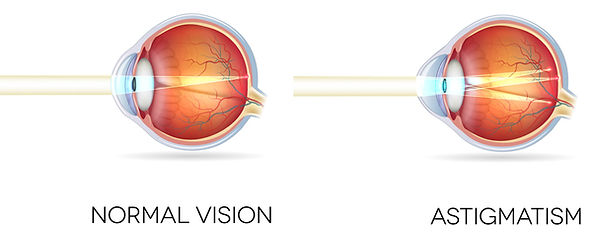
Astigmatism
What Is Astigmatism?
Astigmatism is a common vision condition that occurs when the cornea (the clear front surface of the eye) or the lens inside the eye is irregularly shaped (more like a football than a baseball). This causes light to focus unevenly on the retina, resulting in blurry or distorted vision at all distances.
Astigmatism is not a disease, nor does it mean that you have "bad eyes." Astigmatism is one of a group of eye conditions known as refractive errors. Refractive errors cause a disturbance in the way that light rays are focused within the eye. With astigmatism, light rays are focused in such a way that both nearby and faraway objects may appear blurry. Astigmatism often occurs with nearsightedness (myopia) or farsightedness (hyperopia).
What Are the Symptoms?
People with astigmatism may experience:
-
Blurred or fuzzy vision at near and far distances
-
Eye strain or discomfort
-
Headaches (especially after reading or screen time)
-
Difficulty seeing at night
-
Squinting
-
Frequent changes in eyeglass prescriptions
Mild astigmatism may cause no noticeable symptoms at all.
Children with untreated astigmatism may experience learning difficulties if their vision is not corrected.
What Causes Astigmatism?
Astigmatism is usually inherited and is present from birth, but it can also develop later in life due to:
-
Eye injuries
-
Eye surgery
-
Keratoconus (a progressive thinning of the cornea)
-
Changes in the shape of the cornea over time
Contrary to common myths, reading in dim light or sitting too close to the TV does not cause astigmatism.
Who Gets Astigmatism?
Astigmatism can affect anyone, regardless of age, and it often runs in families. This condition is very common. Some experts report that everyone has some degree of astigmatism, which generally does not change much throughout life. The exact reason for differences in corneal shape remains unknown.
Astigmatism may be:
-
Present at birth (congenital)
-
First noticed during childhood or teenage years
-
Detected during routine eye exams in adults
How Is Astigmatism Diagnosed?
Astigmatism is diagnosed during a comprehensive eye exam that includes:
-
Visual acuity test (reading the eye chart)
-
Refraction test to determine your prescription
-
Keratometry to measure the curvature of your cornea
-
Corneal topography (in some cases) for detailed mapping
Regular eye exams are important, even if you think your vision is fine. Astigmatism can be easily missed at school screenings. All comprehensive eye examinations at Visualeyes Optometry includes screening for astigmatism.
How Is Astigmatism Treated?
The degree of variation determines whether or not you will need a correction for the astigmatism. Usually only individuals with moderate to highly astigmatic eyes need corrective lenses or other treatment.
Treatment options for astigmatism are safe and effective. These include:
-
Prescription Glasses
-
Correct the uneven focus and are the simplest solution.
-
-
Contact Lenses
-
Special “toric” lenses are designed to correct astigmatism.
-
Rigid gas permeable (RGP) or hybrid lenses may be used for higher levels.
-
-
Refractive Surgery
-
Procedures like LASIK or PRK can reshape the cornea to reduce or eliminate astigmatism.
-
-
Orthokeratology (Ortho-K)
-
Special contact lenses worn overnight to reshape the cornea temporarily.
-
Our optometrist will recommend the best treatment based on your age, lifestyle, and prescription needs.
What Is the Prognosis?
Astigmatism is not a disease. It is simply a refractive error that can be easily managed. With proper correction:
-
You can enjoy clear, comfortable vision
-
There are no long-term complications if treated appropriately
-
Untreated astigmatism in children can lead to amblyopia (lazy eye) or learning difficulties
Most people with astigmatism live full, active lives with the right visual correction.
When Should You See an Optometrist?
Make an appointment if you or your child:
-
Have blurry, distorted, or fluctuating vision
-
Experience frequent eye strain or headaches
-
Struggle with night driving or reading
-
Need regular vision checks (especially if you wear glasses or contacts)
Astigmatism is common and treatable. With regular eye exams and the right correction, you can enjoy crisp, clear sight. Call our office today to schedule your comprehensive eye exam!







